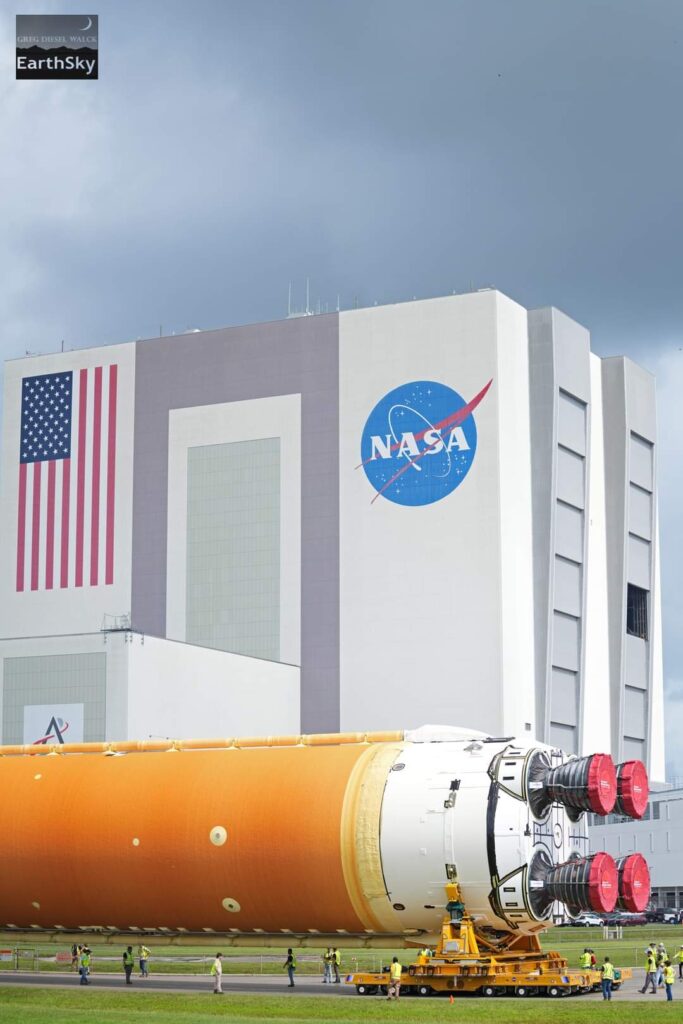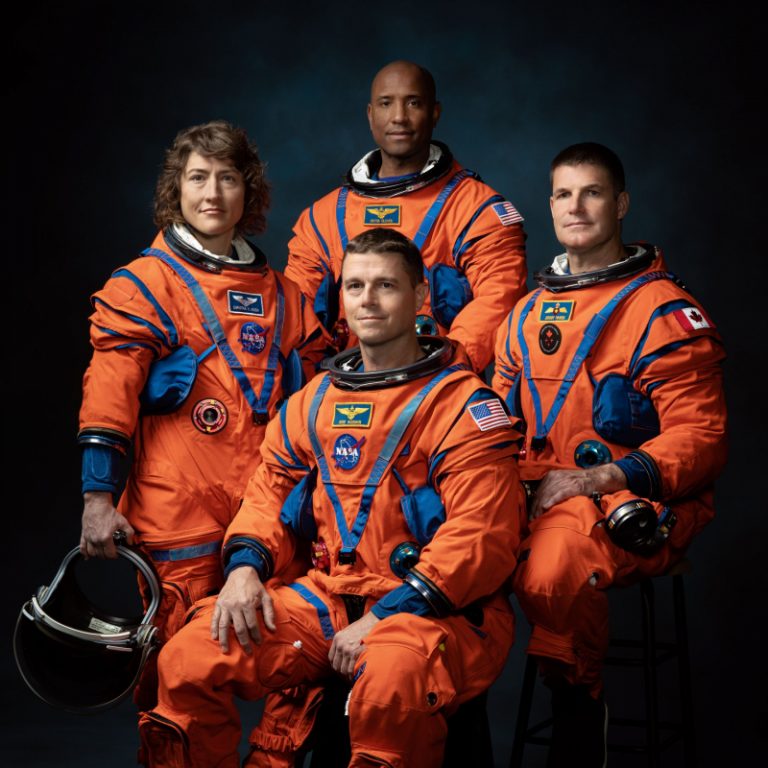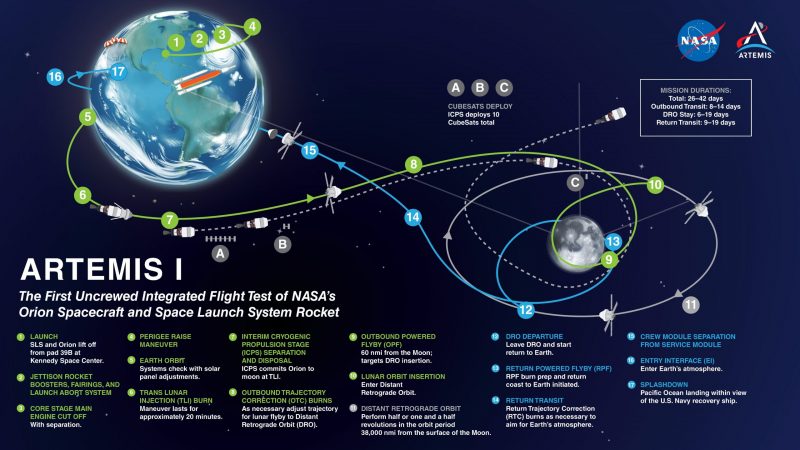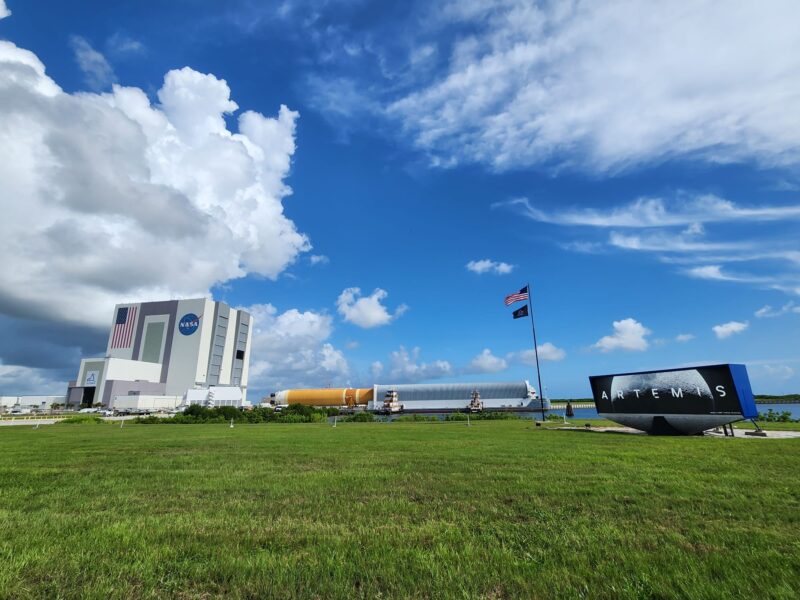EarthSky was there yesterday (Wednesday, July 24, 2024), when the Artemis 2 core rocket stage was unloaded at the Kennedy Space Center in Florida. It had been transported by barge from New Orleans over the previous week. The rocket core was moved to NASA’s Vehicle Assembly Building, where it will be integrated into the Space Launch System for the Artemis 2 moon mission. This mission – the 1st crewed mission for Artemis – will launch no earlier than September 2025.
Artemis 2’s rocket core arrived at KSC this week
A slow boat from New Orleans arrived Tuesday (July 23, 2024) at NASA’s Kennedy Space Center on Florida’s Space Coast. Onboard was the 212-foot-tall (64.6-meter) rocket core stage for the Artemis 2 mission, scheduled to carry humans back to the moon, to circle around it and return, no earlier than 2025. Then, a three-hour effort on Wednesday morning (July 24) – a process NASA had predicted would take 45 minutes – saw the core removed from the barge that had carried it, and ultimately stowed safely inside the massive Vehicle Assembly Building (VAB).
Artemis 2’s core traveled from the Michoud Assembly Facility in New Orleans aboard NASA’s Pegasus barge. The 900-mile (1,450-km) journey took seven days. Pegasus crossed the Gulf of Mexico, then navigated along Florida’s Atlantic coast to Launch Complex 39 at KSC.
Later, once inside the VAB, the core will be prepared for integration into the Space Launch System (SLS), NASA said via its Artemis mission blog.

The Artemis timeline for reaching the moon
NASA’s Artemis missions plan to carry humans back to the moon. NASA announced the newest Artemis timeline in January 2024. Artemis 1 successfully completed its mission in 2022 with an uncrewed test flight that orbited the moon. Artemis 2 will be the first crewed mission to orbit the moon in more than 50 years. Its launch date is no earlier than September 2025. The following mission, Artemis 3, will be the first to return humans to the moon since the Apollo missions. As of now, Artemis 3 is slated for September 2026. And Artemis 4, another mission to take humans to the moon, will be no earlier than September 2028.
The announcement said:
To safely carry out these missions, agency leaders are adjusting the schedules for Artemis 2 and Artemis 3 to allow teams to work through challenges associated with first-time developments, operations and integration.

Official announcements from NASA
NASA Administrator Bill Nelson said in January:
We are returning to the moon in a way we never have before, and the safety of our astronauts is NASA’s top priority as we prepare for future Artemis missions. We’ve learned a lot since Artemis I, and the success of these early missions relies on our commercial and international partnerships to further our reach and understanding of humanity’s place in our solar system.
Catherine Koerner of NASA added:
We are letting the hardware talk to us so that crew safety drives our decision-making. And we will use the Artemis 2 flight test, and each flight that follows, to reduce risk for future moon missions. We are resolving challenges associated with first-time capabilities and operations, and we are closer than ever to establishing sustained exploration of Earth’s nearest neighbor under Artemis.
In order to safely carry out our upcoming #Artemis missions to the Moon with astronauts, we are now targeting September 2025 for Artemis II and September 2026 for Artemis III.
Safety is our top priority. https://t.co/AjNjLo4U6E pic.twitter.com/VE74OtlUr6
— NASA (@NASA) January 9, 2024
The astronauts who will circle the moon
On April 3, 2023, NASA announced the four astronauts who will be taking part in its Artemis 2 mission (officially Artemis II). Notably, the mission is scheduled to carry astronauts around the moon in September 2025. It’s preparatory for Artemis 3, which will land the first humans on the lunar surface in over 50 years. The four Artemis 2 astronauts are Christina Hammock Koch, Victor Glover, Reid Wiseman and Canadian Jeremy Hansen. Learn more about them below.
Here they are. @SenBillNelson announces the #Artemis II crew, the next astronauts to fly around the Moon:@Astro_Christina@Astro_Jeremy@AstroVicGlover@Astro_Reid
We go together. https://t.co/XdUizg2Wye pic.twitter.com/6Yo4I2lKeJ
— NASA (@NASA) April 3, 2023
They're going to the Moon! Introducing the #Artemis II astronauts:
Reid Wiseman (@astro_reid), Commander
Victor Glover (@AstroVicGlover), Pilot
Christina Koch (@Astro_Christina), Mission specialist
Jeremy Hanson (@Astro_Jeremy), Mission specialisthttps://t.co/Hy1110MOEi pic.twitter.com/SeETL5iURu— NASA's Johnson Space Center (@NASA_Johnson) April 3, 2023
Christina Koch
Meet the first member of our #Artemis II Moon crew: mission specialist @Astro_Christina!
Christina Koch visited the @Space_Station in 2019, where she took part in the first all-woman spacewalk. She began her career as an electrical engineer at @NASAGoddard. pic.twitter.com/mi82SayXUm
— NASA (@NASA) April 3, 2023
Jeremy Hansen
Representing the @csa_asc on #Artemis II to the Moon is @Astro_Jeremy, from London, Ontario.
Jeremy Hansen was a fighter pilot before joining CSA, and currently works with NASA on astronaut training and mission operations. This will be Hansen’s first mission in space. pic.twitter.com/zIVetAQeFE
— NASA (@NASA) April 3, 2023
Victor Glover
Our #Artemis II pilot is @AstroVicGlover!
Victor Glover is part of our 2013 class of @NASA_Astronauts and was the pilot for NASA’s @SpaceX Crew-1 mission. He’s logged 3,000 flight hours in more than 40 different aircraft, and will pilot @NASA_Orion around the Moon. pic.twitter.com/P0zJ8pwaeL
— NASA (@NASA) April 3, 2023
Reid Wiseman
…and rounding out our #Artemis II Moon crew: mission commander @Astro_Reid!
Reid Wiseman lived & worked aboard the @Space_Station as a flight engineer in 2014. He also commanded the undersea research mission NEEMO21, and most recently served as Chief of the @NASA_Astronauts. pic.twitter.com/AincR66wpf
— NASA (@NASA) April 3, 2023
Here’s the announcement video
Watch NASA’s announcement of the Artemis 2 astronauts for a mission around the moon. NASA made the announcement on April 3, 2023.
A plan to return humans to the moon
The Apollo program, which first took humans to the moon in the late 1960s and early 1970s, has long awaited a successor. Enter Artemis, the NASA program that will return humans to the moon. Artemis will be a multi-stage program using new technology, including the powerful SLS rocket. Artemis 1, an uncrewed test mission that circled the moon, successfully completed its mission on December 11, 2022. The next stage of the program, Artemis 2, will take a crewed mission around the moon no earlier than September 2025.
The Artemis program is the name for NASA’s missions to return humans to the moon.
Artemis 1
Artemis 1 launched to the moon from Kennedy Space Center in Florida at 1:47 a.m. EST on November 16, 2022. Overall, the uncrewed flight covered a total of 1.4 million miles (2.2 million km) on its journey. The Orion capsule, the compartment that will hold the future crew, spent more time in space than any human spacecraft has without docking to a space station. It also set a new record for the greatest distance from Earth – for any craft built for human space travel – of 268,563 miles (432,210 km). The Orion spacecraft splashed down in the Pacific Ocean on December 11, 2022.

Artemis 2, 3, 4 and beyond
Artemis 2 will be the first crewed flight for the Space Launch System and Orion spacecraft. This mission will follow in the footsteps on Artemis 1, taking astronauts on a journey around the moon without landing. The four crew members should launch toward the moon sometime in September 2025. NASA announced the astronauts of the Artemis 2 mission on April 3, 2023.
Ultimately, Artemis 3 will be the mission that finally lands on the moon. The crew of four will include the first woman and the first person of color to go to the moon. A Human Landing System (HLS) – still in development – will launch prior to Artemis 3 and will await the Orion spacecraft at the moon. Then, two astronauts will descend to the moon on the HLS and spend approximately six days on the surface. This mission will launch no earlier than September 2026.
Artemis 4 and Artemis 5 are additional missions that plan to land on the moon, with possible launch dates of September 2028 and September 2029, respectively.

The vision of the Artemis program
Ultimately, the Artemis program aims to send the first humans back to the moon by the middle of this decade. When they go, they’ll be aiming for the moon’s south pole, a place that scientists have discovered in recent decades has large amounts of water ice. Water contains oxygen, so processing it will make it possible for future astronauts to stay longer.
Someday, visionaries still hope, we will have a permanent presence on the moon. And we will go to Mars.
Indeed, such dreams are an integral part of humanity’s natural wanderlust in the 21st century. And so future historians might look back at our time – and at the Artemis missions – as the moment humanity took a true giant leap to space, maybe this time for good.
Bottom line: The Artemis 2 misson will carry four astronauts around the moon in 2025. On July 24, 2024, the Artemis moon rocket core was unloaded at Kennedy Space Center.











